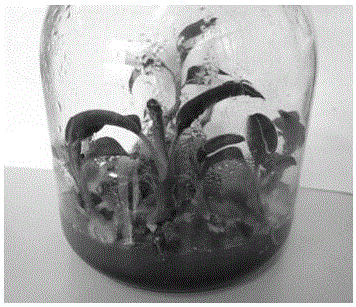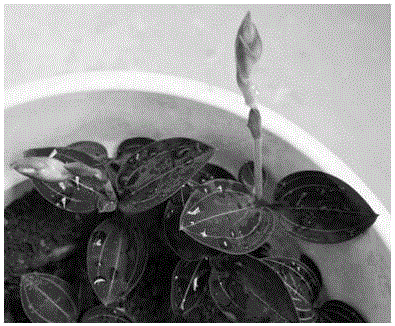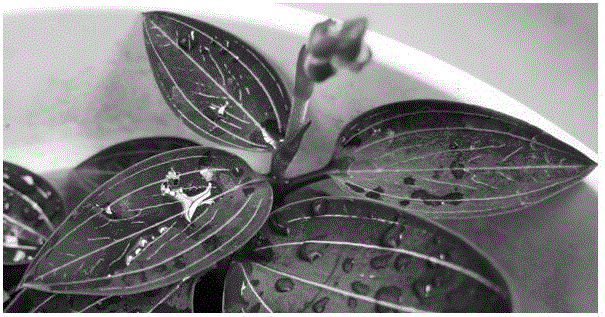Tissue culture method for club moss
A technology of tissue culture and male stone pine, applied in horticultural methods, botanical equipment and methods, horticulture, etc., can solve the problems of sensitive fungicide response, no authoritative mature technology for tissue culture, and no detection, etc., and achieve a high survival rate High, solve the effect of poor natural fertility and strong root vitality
- Summary
- Abstract
- Description
- Claims
- Application Information
AI Technical Summary
Problems solved by technology
Method used
Image
Examples
Embodiment 1
[0017] A male stone pine tissue culture method, comprising the following:
[0018] (1) Take the wild male stone pine as explants and cultivate them after 2 days of clean sand, remove the stems of the roots and leaves, wash the surface, soak in 1wt.% sodium hypochlorite solution for 15 minutes, rinse with tap water, put in 75% Sterilize in v / v alcohol for 30 seconds, then sterilize with 0.1wt.% mercuric chloride for 7 minutes, rinse with sterile water 4 times;
[0019] (2) Under sterile conditions, cut the stems into 1.5cm-long stem segments, inoculate them on the induction medium, continuously light for 8 hours a day, light intensity 1500lx, culture temperature 23±1℃, and cultivate for 150 days;
[0020] (3) Subculture; the stem buds formed on the induction medium were transplanted to the growth medium under sterile conditions, continuously illuminated for 12 hours a day, the light intensity was 2000lx, the culture temperature was 25±1°C, and cultured for 130 days. Complete r...
Embodiment 2
[0024] A male stone pine tissue culture method, comprising the following:
[0025] (1) Use wild male stone pine as an explant and cultivate it after 3 days of clean sand, remove the stems of the roots and leaves, after cleaning the surface, soak in 1wt.% sodium hypochlorite solution for 15 minutes, rinse with tap water, put in 75% Sterilize in v / v alcohol for 30 seconds, then sterilize with 0.1wt.% mercuric chloride for 10 minutes, rinse with sterile water 5 times;
[0026] (2) Under sterile conditions, cut the stems into 1.5cm long stem segments, inoculate them on the induction medium, continuously light for 8 hours a day, light intensity 2000lx, culture temperature 23±1℃, and cultivate for 150 days;
[0027] (3) Subculture; the stem buds formed on the induction medium were transplanted to the growth medium under sterile conditions, continuously illuminated for 12 hours a day, the light intensity was 2500lx, the culture temperature was 25±1°C, and cultured for 130 days. Comp...
Embodiment 3
[0031] A male stone pine tissue culture method, comprising the following:
[0032] (1) Use wild male stone pine as an explant and cultivate it after 3 days of clean sand, remove the stems of the roots and leaves, after cleaning the surface, soak in 1wt.% sodium hypochlorite solution for 15 minutes, rinse with tap water, put in 75% Sterilize in v / v alcohol for 30 seconds, then sterilize with 0.1wt.% mercuric chloride for 8 minutes, rinse with sterile water 5 times;
[0033] (2) Under sterile conditions, cut the stems into 1.5cm-long stem segments, inoculate them on the induction medium, continuously light for 8 hours a day, light intensity 1700lx, culture temperature 23±1℃, and cultivate for 150 days;
[0034] (3) Subculture; the stem buds formed on the induction medium were transplanted to the growth medium under aseptic conditions, continuously illuminated for 12 hours a day, the light intensity was 2300lx, the culture temperature was 25±1°C, and cultured for 130 days. Compl...
PUM
 Login to View More
Login to View More Abstract
Description
Claims
Application Information
 Login to View More
Login to View More - R&D
- Intellectual Property
- Life Sciences
- Materials
- Tech Scout
- Unparalleled Data Quality
- Higher Quality Content
- 60% Fewer Hallucinations
Browse by: Latest US Patents, China's latest patents, Technical Efficacy Thesaurus, Application Domain, Technology Topic, Popular Technical Reports.
© 2025 PatSnap. All rights reserved.Legal|Privacy policy|Modern Slavery Act Transparency Statement|Sitemap|About US| Contact US: help@patsnap.com



